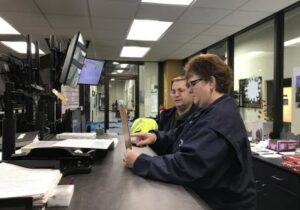 A chemical spill in the Ohio River was an unusual situation for both the water quality and production operations staff at Louisville Water. A barge accident on December 19 dumped thousands of gallons of urea ammonium nitrate in the Ohio River near Cincinnati.
A chemical spill in the Ohio River was an unusual situation for both the water quality and production operations staff at Louisville Water. A barge accident on December 19 dumped thousands of gallons of urea ammonium nitrate in the Ohio River near Cincinnati.
The water quality team decided that one way to combat the spill was to shut down the pumps at the Zorn Avenue Pumping Station when the peak of the spill would pass the intake valves in the Ohio River. Larry Bryant, Director of Production Operations, said Louisville Water has never before had an extended planned shutdown of the Zorn Avenue pumps.
 “The water quality team projected the peak of the spill, and we cut off the water intake at that peak,” said Bryant. “We relied on the water quality team to tell us when to shut the pumps off.”
“The water quality team projected the peak of the spill, and we cut off the water intake at that peak,” said Bryant. “We relied on the water quality team to tell us when to shut the pumps off.”
Because they knew the pumps would be turned off for some time, the operations staff at both the Crescent Hill Water Treatment Plant and the B.E. Payne Water Treatment Plant had to fill the remote water system — every tank and reservoir — to capacity, and keep it full, which was the tricky part.
“It was a balancing act on the part of the operations staff to keep everything full before we shut off pumping,” said Bryant. “We tried to project the water that we needed while we were not pumping.”
Operations turned the pumps off between 7 p.m. and 8 p.m. Christmas Day and then turned them back on between 5 a.m. and 6 a.m. the next morning. Ideally, water quality wanted to keep the pumps off for the longest time possible.
“We were able to go without pumping for about 11 hours,” said Bryant. “There were many factors that helped us go that long. While it was unfortunate that it was during Christmas time for the staff, we were lucky that Christmas Day is traditionally the lowest water pumping day of the year.”
But water does get used by the one million customers Louisville Water serves, and once the reservoir got to a specific point, it needed to be filled back up with the pumps at Zorn Avenue. Bryant said there were no issues turning the pumps back on.
“The pumps bring the raw water to the reservoir,” explained Bryant. “The reservoir needs to be at a certain level to provide the right pressure to push it through our treatment process. Once the water is in the reservoir, it flows by gravity, and we operate a series of valves that open and close until we get the finished water.”
Another part of plan was to increase water production at the Payne Plant. It not only had to meet the usual demand and do without the usual supplement from Crescent Hill, it also had to provide water to Crescent Hill.
“The Westport Transfer Station is our biggest remote station and one of its primarily functions is to pump water from the Crescent Hill plant to the Payne Plant to supplement Payne’s production,” explained Bryant. “In this case, we shut the pumps off at the station, and opened up the bypass valves around there and water flowed from the higher pressure of the Payne plant back to the Crescent Hill system. We pulled about 9-10 MGD (million gallons) from Payne to Crescent Hill during this time.”
On Christmas Day and the next two days, the water quality group and plant operators continually analyzed and monitored our treatment process and made minor adjustments to the normal water treatment strategy.
“Water quality told us what treatment changes need to be made, and my team implemented that,” said Bryant.
Bryant had great praise for his entire staff. “Because we had to modify our pumping schedule and our hydraulic plan, we had one-on-one communication with the entire staff because it crossed over all shifts at both plants,” said Bryant. “We had to slow the plant down to a crawl but still meet the demand of our customers, which we did.”
Bryant said the footprint of Crescent Hill was another factor that worked in our favor during this spill. “Crescent Hill is a large treatment plant, and the large footprint of the plant gives us time to react to situations like this,” said Bryant. “Newer facilities would be ⅔ or ½ the size of this plant, but the amount of water we have here because of the space allowed gave us extra time for the spill to pass by.”
The communication between Bryant’s team and Director of Water Quality & Research Dr. Rengao Song’s team was flawless. “We had great coordination between the two groups,” said Bryant. “Everyone was so accessible and cooperative.”
“Larry and his production team played a key role executing our treatment strategy,” said Song. “We asked his team to stop pumping for as long as they could and they did. There was excellent communication between our two teams.”
Both production operations and water quality will continue to monitor the water from the aquifer at Payne plant for the spill. Because the Payne plant uses riverbank filtration, it takes about 45 days for the spill to get into the Payne system, which should be soon. The water quality team does not anticipate any issues with the water but will adjust the treatment strategy if necessary.

